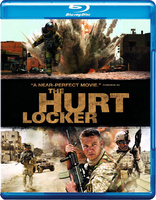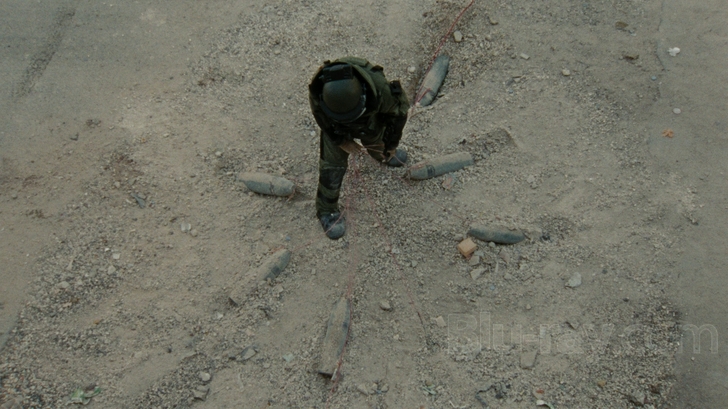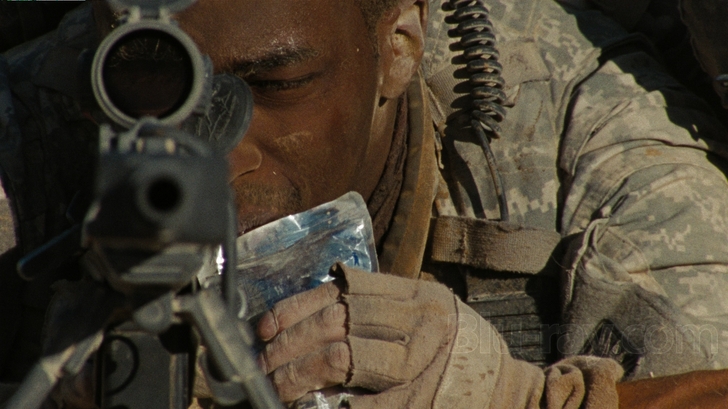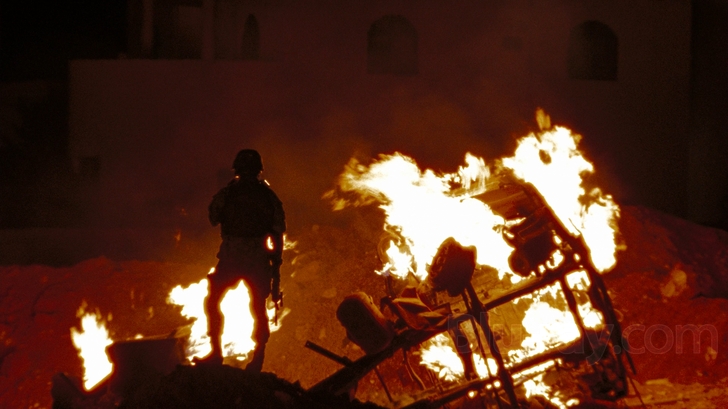The Hurt Locker Blu-ray Movie
HomeThe Hurt Locker Blu-ray Movie 
Summit Entertainment | 2008 | 131 min | Rated R | Jan 12, 2010
Movie rating
7.7 | / 10 |
Blu-ray rating
| Users | 3.8 | |
| Reviewer | 4.0 | |
| Overall | 4.0 |
Overview
The Hurt Locker (2008)
Find a bomb, defuse it. Find a bomb, defuse it. The job is simple enough, but the room for error is zero. Fail to defuse it, and die. This is the daily work of the United States Army's Bravo Company. They patrol Baghdad during one of the Iraq war's most hellish times, trying each day not to get blown up. James joins a tightly knit bomb-disposal unit where Sanborn is already the intelligence expert. James, by contrast, is a real cowboy. Even in the hulking shell of his bomb suit, his swagger is obvious. He has successfully disabled 873 devices, approaching the job with the no-nonsense grit of a Bigelow hero—and the recklessness too. But as the unit faces tougher challenges with each new bomb, the men start to fight James's bullish methods. They have only thirty-eight days left in their rotation. They want to live to see day thirty-nine.
Starring: Jeremy Renner, Anthony Mackie, Brian Geraghty, Guy Pearce, Ralph FiennesDirector: Kathryn Bigelow
| Thriller | Uncertain |
| Action | Uncertain |
| Drama | Uncertain |
| War | Uncertain |
Specifications
Video
Video codec: MPEG-4 AVC
Video resolution: 1080p
Aspect ratio: 1.78:1
Original aspect ratio: 1.85:1
Audio
English: DTS-HD Master Audio 5.1 (48kHz, 24-bit)
English: Dolby Digital 2.0 (192 kbps)
Spanish: Dolby Digital 5.1 (640 kbps)
Subtitles
English SDH, Spanish
Discs
50GB Blu-ray Disc
Single disc (1 BD)
Packaging
Slipcover in original pressing
Playback
Region A (locked)
Review
Rating summary
| Movie | 5.0 | |
| Video | 5.0 | |
| Audio | 5.0 | |
| Extras | 1.5 | |
| Overall | 4.0 |
The Hurt Locker Blu-ray Movie Review
A new standard in War movie excellence is born.
Reviewed by Martin Liebman January 13, 2010You are now in the kill zone.
Since film became a mainstream and commercialized medium for both entertainment and social
commentary, military conflicts have been staples of the Hollywood landscape, a crop of pictures
popping up after -- and sometimes before -- the cessation of hostilities between belligerents.
Post-World War II Hollywood saw fit to churn out dozens of War pictures that were nothing like
those that would come decades later. Often far too clean, spit and polished, and distancing
themselves from the realities of war, even the most splendidly-realized and popular of them all --
pictures like The Longest Day and
Patton -- didn't
necessarily shy away from the truth but they didn't truly capture the essence of war and all its
horrors, and considering the toll the war had taken on the United States and, indeed, the world
at
large, it's no surprise that a little fudging of the truth and bending of realities in favor of feel-good
filmmaking dominated the cinematic landscape. The post-Vietnam era saw filmmakers eschew
this approach, and while the level of visible violence increased, the best pictures and many of
them Oscar-winning films -- Platoon, Apocalypse Now, The Deer Hunter,
and Full Metal Jacket --
chose not to focus on the physical realities of War but instead the emotional toll exacted on the
human soul and psyche. The modern era -- rather than focusing predominantly on the Middle
Eastern conflicts that have defined U.S. foreign and military policy over the past two decades --
has seen filmmakers re-visit the wars of old with an edgier and far more brutally realistic tone,
with pictures
like Saving Private Ryan and We Were Soldiers
being prime examples. Director Kathryn Bigelow's (Point Break) The
Hurt Locker instead portrays the here and now, the picture a fantastically crafted yet
incredibly grim
and
altogether terrifying glimpse into the daily grind and the physical, mental, and emotional
stability of a three-man ordinance demolition unit in Iraq circa 2004.

One of the many deadly concoctions encountered in Iraq.
In 2004 Iraq, an explosives ordinance disposal unit -- whose task it is to secure the perimeter around and disarm deadly improvised explosive devices -- loses its bomb technician to a detonation. He's replaced by Staff Sergeant William James (Jeremy Renner, 28 Weeks Later), a longtime and highly successful technician who nevertheless employs reckless tactics in his disarmament of the explosives, showing little concern for life and limb, both his and of his fellow soldiers. His colleagues-in-arms, Sergeant JT Sanborn (Anthony Mackie, We Are Marshall) and Specialist Owen Eldridge (Brian Geraghty, Jarhead) soon come to disapprove of the Staff Sergeant's tactics, particularly considering the short time remaining in their rotation. Whether lucky, crazy, good, or a combination thereof, James always accomplishes his task -- to the tune of nearly 900 bombs diffused in his career -- but while his work helps preserve the physical body, his reckless style begins taking a toll on Sanborn's and Eldridge's already confused and damaged mental and emotional states.
The Hurt Locker's superficial plot is incredibly simple, and as it becomes obvious as the film moves forward, it isn't at all about its storyline. It's about depth of character, the horrors of war, the emotional scarring wrought by the close proximity to both death and the possibility of death, the repetitive toil of combat operations, the uncertainty of every minute in the field, and the personality-defining way in which each soldier copes with what they have seen and done through the course of their tour of duty. The Hurt Locker offers more a series of interconnected vignettes rather than a single, point-A-to-point-B-to-point-C linear-style plot, the film more concerned not with thematic structure but instead the far greater and overreaching emotional, mental, and psychological undertones that are both developed and reinforced throughout the film, slowly coming to fruition with each new and separate sequence that only connects to the previous through the constant increase in stress, fear, anger, uncertainty, and all of the other many -- and mostly harmful -- emotions that war engenders. Indeed, few films can lay claim to being so emotionally challenging as this when considered from a traditional, structured perspective. While the audience comes to know the characters through a basic and structurally unconnected series of generally repetitive events, the three primaries are developed to the point that they become reflections of the audience, each undergoing the varying intense physical and emotional turmoil that Director Kathryn Bigelow -- and indeed the hells of war as a general rule and as expertly and horrifically reflected here -- has infused into the picture. Rather than a detached observer, the audience becomes a fourth member of the team, a participant that, despite the relative safety of the theater, comes to feel the anguish, experience the horrors, soar with the adrenaline, and understand the agony of combat and the precariousness of life in constantly evolving and potentially destructive conditions.
Indeed, The Hurt Locker's characters are all reflective of basic traits and outlooks on war that will find agreement with a diverse population of audience members. Whether ardent in the commitment to duty, fearful of the daily grind of war, uncertain of the purpose of the conflict, emotionally drained by the stench of death and absence of family, or the painful fragility of hopes and dreams that seem always on the precipice and more in danger of being lost than life or limb, The Hurt Locker speaks, in some way, to all audience members but without the added and thematically damaging forceful message that sometimes nullifies the truer emotions of similar pictures. Of course, the constant "war is hell" theme is the point of the picture, here presented much like many of the Vietnam-era films that analyzed not the physical but rather the deeper psychological pains of war, but Bigelow maintains a general air of neutrality in her presentation, clinging only to the universally accepted notion that, necessary or not, war is indeed hell, and in more ways than the potential for bodily harm. In that regard, The Hurt Locker succeeds because its characters are realistically portrayed, all of them representative of traits that differentiate them one from another while remaining consistently grounded in a reality that contributes to the overall feel of the picture and reinforces the themes of the trauma to the human psyche that's the real enemy in any combat situation, whether the fields of Gettysburg, the snow-covered Ardennes Forest, the steamy jungles of Vietnam, or the dusty streets of Iraq.
Each of the three lead actors -- Jeremy Renner, Anthony Mackie, and Brian Geraghty -- deliver seamless and convincing performances that are highly reflective of the pains both physical and psychological; there's an air of authenticity to each part, and the varied personalities allow for a much broader and far more convincing environment and, indeed, thematic overtone than would simply a collection of nameless, faceless automaton characters that do nothing but go through the motions or look good running around in a bomb suit or brandishing an M4. Additionally, The Hurt Locker's engaging visual style that does well to place the audience in the midst of the action only helps to reinforce the thematic content that allows viewers to feel the anguish of war without actually having boots-on-ground in Iraq. Sometimes employing something of a Documentary style feel, Director Kathryn Bigelow and Cinematographer Barry Ackroyd ensure that viewers become part of the team in a more physical sense as well as through the use of jerky camera movements that are reflective of the chaos and ever-shifting tone of the battlefield. Bigelow's style is somewhat similar to that used by Ridley Scott in the more action-oriented but no less brilliant Black Hawk Down, and while the gritty, grainy feel has become the de facto standard in War movie filmmaking, it proves once again highly effective in The Hurt Locker, the final component to a genre-defining picture that sets the bar incredibly high for Iraq War films for both thematic purpose and tonal effectiveness.
The Hurt Locker Blu-ray Movie, Video Quality 

The Hurt Locker's 1080p, 1.78:1-framed transfer is gritty, messy, and exactly as intended. The harsh visual appearance is reflective of modern-day War pictures, and the abundance of heavy film grain is both natural and welcome considering its purpose in both establishing a tone and reinforcing the film's thematic elements. Earth tones dominate the image; sand, dirt, building façades, and camouflaged uniforms all feature a distinct lack of popping primary colors. Indeed, viewers will be hard-pressed to find more than a hint of bright colors throughout, and this 1080p transfer handles the picture's drab visual tone to perfection. Fine detail is exceptional even through the dense grain structure; low-to-the-ground shots reveal every nuanced spec of sand, dirt, rock, and other random debris that's resultant of a war-torn city. Additionally, intact walls reveal a rough, palpable texturing, and military uniforms and clothing showcase fine stitching in up-close shots. Flesh tones are consistently accurate, and blacks are deep and true. This is the kind of material that's tailor-made for Blu-ray. It's neither flashy nor pretty, but the format's ability to retain the filmmakers' intended visual style, particularly one this grainy and harsh, allows The Hurt Locker to stand as a reference-quality disc for this sort of film.
The Hurt Locker Blu-ray Movie, Audio Quality 

The Hurt Locker features a dazzling reference-standard DTS-HD MA 5.1 lossless soundtrack. The track's most pronounced effects, of course, stem from military equipment and action scenes, but there's also a solid but subtle atmosphere that penetrates quieter scenes that round out a hearty and engaging listen. Still, the action-oriented sound effects prove to be show-stoppers, high-end system-sellers, and limit-pushing sonic marvels that stand among Blu-ray's finest audio offerings. Helicopters aggressively but naturally buzz around the soundstage and whirl with ease from one side to the other; fighter jets, too, scream through the listening area with amazing precision and thunderous but altogether crisp and natural power, the sonic boom lingering wonderfully even after the jet is long since gone from the center of the action. Gunshots sparkle, too, and The Hurt Locker offers a wide variety to enjoy. Singular shots from a Beretta 92 (military designation M9) ring out with startling, room-filling, and precise accuracy. The thump of automatic weapons fire pounds out from every corner of the soundstage on several occasions, and the barrage effectively places the listener in the midst of the firefights that bring with them an edge of terrifying fear into the body and mind with every expended cartridge. Additionally, the rat-a-tat thumping of a vehicle-mounted .50 caliber heavy machine gun delivers an awe-inspiring and chest-rattling thud with every shot. Explosions, too, are accompanied by an impressive low-end impact that sends shockwaves through the listening area. The cacophony of wartime sound effects represent The Hurt Locker's defining sonic signature, and it's all reproduced marvelously on Blu-ray. Rounded out by accurate dialogue reproduction, they just don't come much better than this.
The Hurt Locker Blu-ray Movie, Special Features and Extras 

Unfortunately, this Blu-ray release of The Hurt Locker contains only a small assortment of extras. First is an audio commentary with Director Kathryn Bigelow and Writer Mark Boal that speaks on the real-life stories that inspired the film, the unique aspects of the production, shooting in the Middle East, the performances of the cast and their preparation for their roles, the authenticity of the picture, the challenges of the shoot, and much more. The participants speak with a reserved, quiet tone but deliver a strong commentary that proves well worth a listen. The Hurt Locker: Behind the Scenes (1080i, 12:36) is a basic-in-structure but nevertheless worthwhile piece that features cast and crew speaking on the War itself, the structure and themes of the film, the work and style of Director Kathryn Bigelow, the characters' traits, the work of Cinematographer Barry Ackroyd, the authentic conditions that come with shooting in the Middle East, and more. Also included is an Image Gallery with an optional Q&A session recorded at the Institute of Contemporary Art in London (1080p, 23:30).
The Hurt Locker Blu-ray Movie, Overall Score and Recommendation 

A relentlessly terrifying experience that's more than the sum of the shots fired or the bombs disarmed, Director Kathryn Bigelow's The Hurt Locker is a picture that's true to the horrors of War -- particularly the psychological anguish incurred even in place of physical harm -- and not the run-and-gun action normally associated with lesser-in-meaning War movies. With a strong cast; exceptional direction and cinematography; and a moving, often gut-wrenching thematic overtone that analyzes the fragility of the human condition through the prism of the uncertainty of war, The Hurt Locker sets a new standard for genre excellence and has solidified itself as a contemporary War movie classic. Summit's Blu-ray release delivers where it counts, exhibiting reference-grade video and audio presentations. A decent but ultimately underwhelming supplements package should not interfere with the decision to add this otherwise exceptional film and fantastic disc to any Blu-ray collection. The Hurt Locker comes highly recommended.
Similar titles
Similar titles you might also like

Green Zone
2010

The Kingdom
2007

13 Hours: The Secret Soldiers of Benghazi 4K
2016

Rambo III 4K
1988

Rambo: First Blood Part II 4K
1985

Dunkirk 4K
2017

Body of Lies
Special Edition
2008

Tears of the Sun
2003

Lord of War 4K
2005

Home of the Brave
2006

The Delta Force 4K
1986

U-571 4K
25th Anniversary Edition
2000

Lone Survivor 4K
2013

First Blood 4K
Rambo
1982

Crimson Tide
1995

War, Inc.
2008

5 Days of War
2011

Zero Dark Thirty 4K
2012

Assassin's Bullet
2012

Sniper: Reloaded
2011

